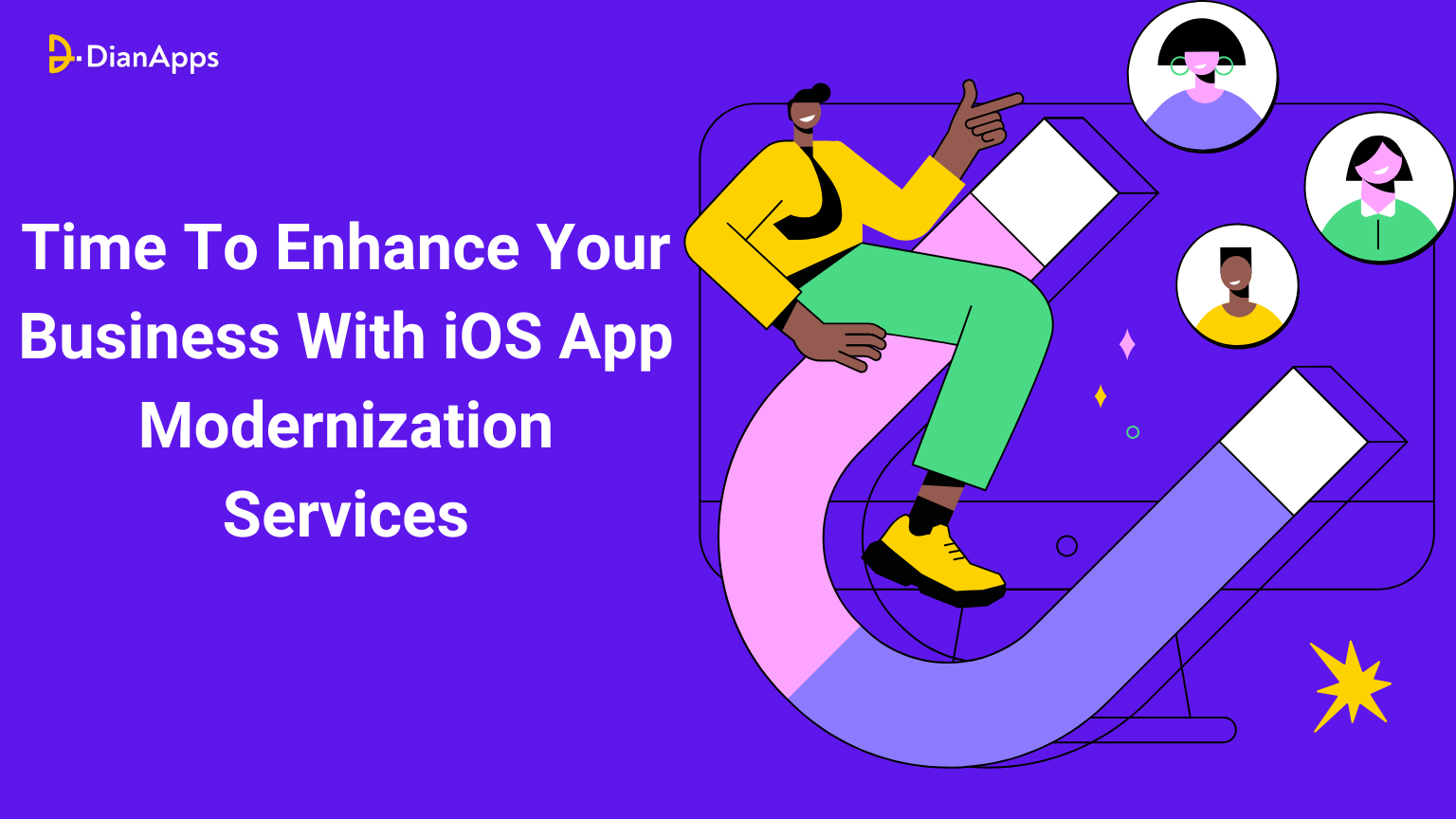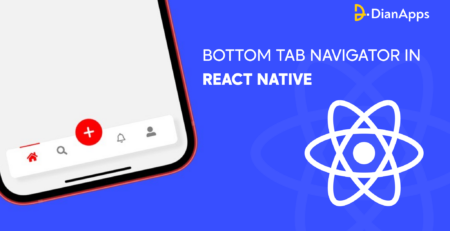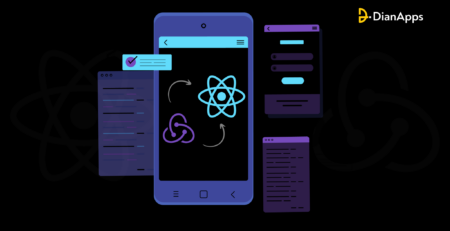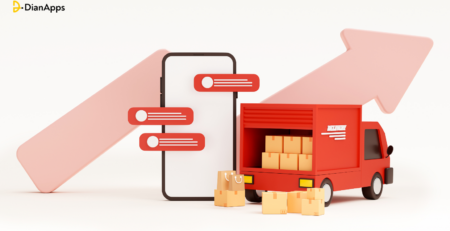Time To Enhance Your Business With iOS App Modernization Services
Times have modified the old perception of building apps removing the dependency of relying on single business providers. Today, if businesses need to upgrade their existing app to a cloud-first model, they can simply look up for legacy modernization that involves transitioning an organization’s applications, processes, and data management to a cloud-first approach.
Don’t know when is the best time to enhance your business app? Well, is your business in need of improving its organizational or technical capabilities? Are you looking to enhance the quality of your customer and employee experiences? Do you need to boost forward your market in order to welcome new customers, offerings, or updates?
If all or any one of these questions is a YES! You know it’s time to escalate your business with app modernization services!
In this blog, we will be highlighting the enhancements with respect to iOS devices. From importance to trends and implementation strategies, you are going to experience every inch of iOS app modernization services here!
Also read: Top practices tools benefits of iOS app development services.
What is App Modernization?
Application modernization is the process of updating out-of-date software with more advanced computing methods, such as enhanced infrastructure platforms, languages, and frameworks. Sometimes this method is also called legacy modernization or legacy application modernization.
Why is iOS App Modernization Important for Businesses?
Modernizing your iOS applications is crucial for every company or organization. It takes care of more than just pressing technical issues. However, it also establishes the groundwork for long-term expansion, creativity, and competitiveness in the ever evolving digital world of today.
New technological developments have a significant influence on consumer behavior and corporate operations since digital transformation is upending whole sectors.
As a result, companies must update their present software programs to meet the needs of their clientele. All businesses, no matter how big or small, must operate consistently in order to have long-term success.
Read the 5 proven iOS app development strategies applied by top companies
Applications that are already in use may not function with the necessary productivity and efficiency if they are developed using antiquated architecture or contain outmoded functionality. It becomes challenging for organizations to provide a satisfactory client experience while using older software.
As a result, companies must update their applications using cutting-edge technology. Through this approach, companies may benefit from new technological developments and gain a competitive edge. Based on current market statistics, a significant number of firms have used mobile app development services.
According to Market Research Future’s (MRFR) most recent research study, the iOS app modernization services market is expected to reach $24.8 billion at a compound annual growth rate (CAGR) of 16.8% by 2030.
Application modernization is the third most important goal for CIOs, according to a recent State of the CIO Study 2023. To update their current apps, several startups and corporations search for the best digital transformation companies.
Why does application modernization matter to organizations in the end? These are the explanations listed below.
Signs You Need iOS App Modernization Solutions For Your Business

Sign 1: Crashes That Happen Slowly and Often Diminished Productivity
Does it take longer than planned for your app to open? Does it crash each time a large file is shared? App optimization can resolve these issues.
But, it’s time for app modernization if it’s negatively affecting the productivity of your team and the efficiency of your company.
Sign 2: Higher-than-expected app maintenance expenses
Is your maintenance charge prohibitively expensive? Because historical systems lack a centralized module for data processing, maintaining them can be extremely expensive.
This cost is further increased by technical debt, license fees, routine maintenance expenses, and frequent crashes.
Rather than balancing the cost and upkeep requirements, update your outdated software. It would be less expensive than keeping the previous ones in place.
Sign 3: Incompatible with Up-to-Date Apps and Software
Every piece of software and application in your company has to function properly together. If not, you might think about updating the outdated program. This mismatch hurts your clients as well as the expansion of your organization.
Sign 4: Over-Surveillance of Hardware
Because legacy systems rely on specific hardware, maintenance expenses are higher. You pay more for the subpar application performance than for the hardware reliance. You must thus move those outdated programs to the cloud.
Sign No. 5: Unsecured System
Security standards are evolving in tandem with cyberattacks. Using antiquated software to run a firm invites hackers.
These systems might not be safe enough to fend off sophisticated and modern security attacks. Modernizing your applications is a safer method of defending your company from such intrusions.
Sign 6: Not Mobile Compatible
Older systems are frequently not mobile-friendly because they were created for desktop use. The applications cannot be accessed or used by your clients due to this device dependence.
The goal of application modernization is to make apps cross-device-compatible, responsive, and mobile-friendly.
Sign 7: Doesn’t Meet Present Needs
Technology and business requirements evolve throughout time. Older applications might not function properly now. They could not have the features, scalability, or integration skills required for contemporary corporate operations.
By updating these programs, you may better meet current requirements and increase their effectiveness and usefulness for increased company success.
Hire DianApps iOS app developers to build or improve apps in just 45 days!
iOS App Modernization Benefits
Adjusting to Shifts in the Market
Businesses can quickly adjust to shifting consumer expectations and market conditions thanks to modernization. iOS applications that are agile and scalable help businesses change course more successfully. and react to market conditions more quickly.
Making Use of New Technologies
Older systems frequently can’t make use of the latest technological advancements. The adoption of AI, microservices, cloud computing, and other cutting-edge technologies is facilitated by modernization. Better performance, quicker processing, and increased operational efficiency are the outcomes of this.
Reduction of Expenses and Enhancement of Resources
Older systems need more upkeep and assistance. As a result, operating costs increase. Applications that are updated are more productive. As a result, this uses less resources overall and lowers IT expenses.
Enhanced Customer Satisfaction and User Experience
Users of today expect flawless experiences. Personalized experiences, quicker response times, and user-friendly interfaces are all made possible by modernization. Therefore, it could aid businesses in raising client happiness and loyalty levels.
Getting Used to Digital and Mobile Trends
More and more platforms are becoming digital and mobile, and new apps accommodate these tastes. Companies may take advantage of new trends and make sure their applications facilitate great user engagement.
Read the trends of iOS app development in 2024!
Cutting Down on Security Risks
Because of their antiquated security protocols, legacy systems are frequently exposed to security risks. Robust security procedures are included into modern apps. Consequently, it lowers the possibility of breaches and guarantees adherence to data protection laws.
Facilitating Innovation
Innovative ideas can flourish in modernized applications. They make it possible to incorporate cutting-edge technology. Businesses are therefore able to experiment, iterate, and develop more quickly. Through the integration of cutting-edge technological trends, they may attain superior growth without impeding operations.
Prospective-Looking
By modernizing, companies make sure they’re ready for new developments and shifts in the technology world. It helps them to stay current and flexible in the face of changing market trends.
Top Trends of iOS App Modernization That Will Help You Boost Your Business
Architecture Native to the Cloud
Cloud-native architecture entails creating apps that are particularly made to function well in cloud settings. It makes it possible to scale, adapt, and move across various cloud platforms. Microservices, containers, and orchestration technologies (like Docker and Kubernetes) are frequently used in this manner.
Containerization and Microservices
Monolithic apps are divided into more manageable, standalone services using microservices. Applications may execute in an isolated environment thanks to containers. It offers quicker deployment, scalability, and simpler maintenance. While containers provide consistent operation across several settings, microservices allow for the autonomous creation and scalability of components.
API-Centric Approach
The foundation of application modernization is APIs, or application programming interfaces. It enables smooth system-to-system communication. Integration between dissimilar systems is facilitated via API integration. As a result, interoperability is supported. It makes it possible to create integrated, flexible applications.
CI/CD and DevOps
Collaboration between the development and operations teams is emphasized by DevOps techniques. Software delivery procedures are automated using Continuous Integration/Continuous Deployment (CI/CD) pipelines. DevOps guarantees a quicker speed to market by quickening the development cycle. By automating testing and deployment, it also upholds the quality of the product.
Head ahead to read the top 6 CI/CD strategies used by top software development companies!
Migration and Upgrades for Legacy Systems
Numerous businesses continue to use outdated systems. This makes it harder for them to remain competitive in the changing industry. The conversion of legacy systems guarantees interoperability with contemporary technology.
Both performance and technological backwardness are improved. Upgrades to platforms or cloud migration enable more cost-effective and scalable solutions. Modernizing outdated apps is therefore one of the biggest trends in the industry.
Integration of AI and Machine Learning
Applications utilizing AI and machine learning techniques are in great demand for their integration. Businesses use AI and ML to build mobile apps in order to automate processes, do predictive analytics, and make wise decisions. AI-powered apps analyze enormous volumes of data to enhance performance and automate operations.
Low- and No-Code Programming
Low-code and no-code platforms are highly sought after. Using pre-built components, they enable app developers with little or no coding experience to create fully functional applications. It encourages the creation of apps and gives citizen developers more authority. In the end, this promotes creativity by facilitating quick deployment and prototyping.
Adoption of Hybrid and Multiple Clouds
Hybrid or multi-cloud approaches are becoming popular among corporations as a means of modernizing their applications. In an effort to get more flexibility and data storage capacity, they are now looking to switch to contemporary cloud services.
Through the utilization of various cloud providers’ services, businesses can get increased efficiency. By utilizing the advantages of several cloud environments, companies may maximize performance and avoid vendor lock-in by implementing hybrid or multi-cloud adoption.
Migration and Management of Legacy Data
It is among the most popular App Modernization trends available right now. Businesses require efficient methods to manage the substantial quantity of data that is gathered since applications must deal with enormous volumes of data.
Through application modernization, companies may manage their old data more intelligently. as well as transferring information to cloud-based storage and putting data governance structures in place. Thus, this unlocks the potential of data analytics and insights while assisting in maintaining data integrity, accessibility, and security.
Customer-focused methods
For any business, one of the most important things is their customers’ contentment. Customer behavior varies in tandem with technological advancements. Therefore, in order to satisfy customers’ expectations, firms must upgrade their application.
Here, app modernization assists companies in putting user experiences first by providing responsiveness, customization, and easy-to-use interfaces. It helps to improve client involvement, loyalty, and satisfaction.
As a result, it promotes corporate success and expansion.
Effective iOS App Modernization Steps To Follow
A successful application modernization strategy requires thorough planning and flawless implementation. For effective implementation, businesses seeking to achieve certain business goals must comprehend application modernization.
The essential actions for putting into practice a successful application modernization plan are outlined below.
1. Evaluation and Setting Priorities
Examine your current application to determine its advantages, disadvantages, and suitability for modernization. For each application, evaluate the possible return on investment, technical debt, and business value.
Sort applications into priority groups according to their importance, influence on organizational objectives, intricacy, and modernization viability.
This will provide you with a detailed implementation path for modernizing your apps.
2. Clearly state your goals and schedule.
Establish clear objectives before utilizing application modernization services. Whether it’s facilitating scalability, cutting expenses, strengthening security, or boosting performance. Create a comprehensive strategy that includes the resources needed for each stage of modernization, as well as the order of activities, deadlines, and milestones.
3. Pick Certain Modernization Strategies
Determine if apps should be moved to more recent platforms or the cloud in order to take use of their advantages. It is up to you to determine whether to reorganize the architecture or application code. This will assist you in integrating with various architectures, microservices, and contemporary design patterns.
4. Use DevOps and Agile Development Techniques
During the modernization process, embrace agile development approaches to iterate, cooperate, and react quickly to changes. Use DevOps techniques in software development to automate processes and improve communication between the development and operations teams. Continuous deployment and integration will be ensured by doing this.
5. Gradual Method and Examination
Divide the modernization of your applications into smaller, easier-to-manage stages. It will reduce interruptions and promote ongoing development. At every level of modernization, make sure all components are functioning, performing, secure, and compatible by conducting comprehensive testing.
6. Pay attention to compliance and security
Incorporate strong security measures to defend your legacy apps against online attacks. Ensure that your application complies with all applicable legislation and protects user privacy. Examine if the app modernization complies with data governance laws and industry-specific compliance standards.
7. User-Centered Experience and Design
When modernizing your old apps, make an effort to adopt a user-centric approach. Make the user experience your top priority by creating user-friendly interfaces, improving responsiveness, and offering customized experiences. You can get user input for this both during and after app modernization. For ongoing progress, you may also apply their observations to subsequent versions.
8. Make Resource and Skill Investments
Adopt a focused approach for app modernization and skill development. Offer instruction or recruit committed app developers with knowledge of contemporary technology. They know just how to use the newest technological advancements for effective application modernization. You can allot enough funds, personnel, and time for the modernization process in order to maximize costs.
How DianApps Enhances iOS Apps With Their Legacy Modernization Services?
The leading iOS app development company is DianApps with digital transformation capabilities. Our large in-house staff of skilled developers and tech specialists specializes in modernizing old or current applications with cutting-edge technologies.
We use cutting-edge procedures in our application modernization process. Here, the emphasis should be on developing apps that surpass both the demands of the market today and the expectations of users future.
App modernization services turn outdated apps into cutting-edge, contemporary, and flexible solutions by utilizing a range of cutting-edge technologies. These technologies are essential for improving user experience, security, scalability, and performance.
Here are the following technologies used by us to improve your existing applications:
1. Utilizing cloud computing
The core of app modernization is cloud computing, which provides cost-effectiveness, scalability, and flexibility. Cloud computing platforms like AWS, Azure, and Google Cloud are used by modernization services to:
- Applications to host.
- Activate DevOps procedures
2. Encourage the development of Microservices Architecture
Through the use of APIs, microservices architecture breaks down large programs into smaller, autonomous services. This method improves:
- The ability to scale
- Adaptability
3. The use of containers
Applications and their dependencies are encapsulated into lightweight containers using containerization technologies like Docker and Kubernetes. Advantages consist of:
- Orchestration
- Portability
- Efficiency
4. The use of serverless computing
Infrastructure upkeep and server administration are abstracted by serverless computing. It provides:
- Economy of scale
- The ability to scale
- Simplifying
5. Current Frameworks for Development
Contemporary programming languages and frameworks like Node.js, Python, and.NET Core allow for:
- Enhancement of Performance
- Productivity of Developers
- Compatibility
6. Designing API-First
Requirements for API-first design encourage the separation of frontend and backend functions. This method makes it easier to:
- Integrity
- Adaptability
- Safety
7. Machine learning and artificial intelligence (AI/ML)
Applications that benefit from AI and ML integration include:
- Automation
- Personalization
- Predictive Analytics
8. Analytics and Big Data
Technologies for big data, such as Apache Hadoop and Spark, allow for:
- Data Entry
- Instantaneous insights
- Data-focused Decision Making
9. Blockchain
Transactions using blockchain technology are safe, open, and unchangeable. Use cases consist of:
- Supply Chain
- Finance
- Information Security
Conclusion
It takes more than just swapping out or upgrading outdated programs with new ones to modernize legacy apps. It is a strategic choice that will affect both your income and company objectives. Thus, it is best to take immediate action rather than postpone it if you see all eight of these indicators or at least half of them.
This new change will first come at a high cost. You may profit from enhanced efficiency, strong security, and great performance if you execute the approach appropriately.
DianApps can assist you in reaching your lofty objectives.
Get in touch with us for advice or to use our services for modernizing legacy apps.




